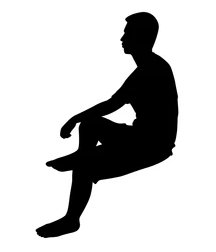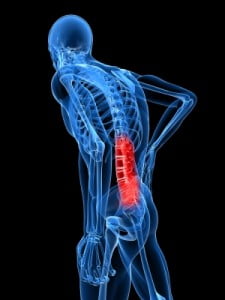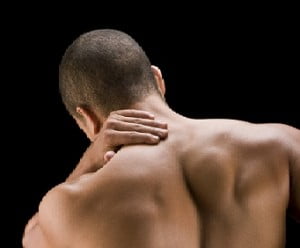 I met a lovely 53 year old gentleman, who was suffering from severe low back and hip pain for over a year, diagnosed with a herniated disc. He had tried physical therapy with some relief, but still was unable to eliminate his pain. After diagnosing and treating muscles in his low back, buttock, and thigh, he reported no low back pain, and was discharged from our office. However, after five years, he returned to our office, stating that he had foot pain, diagnosed with plantar fasciitis, and unable to rock climb or hike without severe pain in his calves and feet. After identifying and treating multiple muscles in his calves, shins, and feet, he reported 100% relief, and even finished a 10 day rock climbing trip. Although you may be given one diagnosis, sometimes we find muscle involvement and are able to eliminate the pain!
I met a lovely 53 year old gentleman, who was suffering from severe low back and hip pain for over a year, diagnosed with a herniated disc. He had tried physical therapy with some relief, but still was unable to eliminate his pain. After diagnosing and treating muscles in his low back, buttock, and thigh, he reported no low back pain, and was discharged from our office. However, after five years, he returned to our office, stating that he had foot pain, diagnosed with plantar fasciitis, and unable to rock climb or hike without severe pain in his calves and feet. After identifying and treating multiple muscles in his calves, shins, and feet, he reported 100% relief, and even finished a 10 day rock climbing trip. Although you may be given one diagnosis, sometimes we find muscle involvement and are able to eliminate the pain!
muscle pain posts Archives
How important is your diagnosis?
Patient Story – Meet Parker
I had the pleasure of meeting Parker (name changed for privacy) a few years ago. I met Parker after he had extensive surgery related to his progressive scoliosis. He reported pain in his chest, spine, and neck. He had received many nerve block injections to his spine without relief. His physical examination identified multiple muscles as a source of his pain.
After treatment to various muscles in his upper and lower body, Parker reported significant relief in pain. He was able to start playing ice hockey and running in 10K races.
Although Parker had a successful fusion to treat his curving spine, he still had severe pain, which came from altered muscle tissue. Muscle treatment plus the fusion allowed Parker to reclaim his life. Without the addition of muscle treatment, a successful surgery would not have had a good outcome.
Sitting with your legs crossed may be contributing to your back pain
Think of some of the ways you sit. Whether taking a ride on the subway, waiting patiently at the doctor’s office, or sitting as a passenger in a car, the way we sit, especially for prolonged periods can have an effect on the pain we may experience in our low back.
For many of us, sitting with our legs crossed feels comfortable in the moment but have you ever considered how this can affect your back and cause pain? What happens to your spine and muscles when sitting with your legs crossed for an extended period of time? When considering good posture, a large component is keeping your spine neutral and avoiding positions that twist the spine or cause misalignment. When sitting with your legs crossed, your pelvis becomes tilted and unconsciously, we tilt our entire torso towards one side. There is a curvature towards one side in the low back which then creates problems in other areas of the spine. Naturally, with a tilt of the pelvis, the upper body will compensate by leaning the opposite direction to maintain balance. Working from the bottom up, pressure on the lumbar spine will cause curvature and misalignment in the thoracic spine. This places strain on the cervical spine to keep the head in the upright position.
Sitting with our legs crossed can also affect our muscles. There are two common sitting positions that we should be mindful of, knee over knee or foot over knee for a prolonged period can cause a tightness in the hamstrings, hip flexors and glute muscles. The iliopsoas, one of the major hip flexor muscles, is responsible for external rotation of the femur and an integral part in maintaining posture. This muscle may become strained due to contraction while the pelvis is tilted. You may notice soreness and tenderness in the low back and hip area. Similarly, sitting foot over knee can over time damage the muscles in the inner thigh. Most commonly, the sartorius muscle can become tight and cause discomfort when sitting with the calf over the knee. At the Norman Marcus Pain Institute, Iliacus and Psoas muscles on the hip can be treated for pain. As one of the most common muscles causing pain for patients, when treated, the Iliacus and other hip flexors can provide great relief for pain in the low back, buttock and groin.
Instead of sitting with crossed legs, sit in a chair with height necessary to place both feet flat on the floor. While sitting upright with your back against the chair, you may want to consider placing a cushion under your bottom that can add support to the low back.
References
Lee BJ, Cha HG, Lee WH. The effects of sitting with the right leg crossed on the trunk length and pelvic torsion of healthy individuals. J Phys Ther Sci. 2016 Nov;28(11):3162-3164. doi: 10.1589/jpts.28.3162. Epub 2016 Nov 29. PMID: 27942141; PMCID: PMC5140821.
Best Posture for Reading: How to alleviate back pain
There’s nothing better than snuggling into a good book. But are you experiencing back pain while sitting and reading for an extended period? Back pain can often be caused by improper posture. While reading, whether using a physical book or an electronic device, many people experience back pain in the neck and shoulder or in the low back. Here are some ways to alleviate back pain while reading.
Reading can cause strain on the neck and shoulders if there is a tilt in the neck to look down at your book or device. While sitting and reading, it’s important to place your reading material at eye level. Sitting with your head leaning forward and back hunched can cause hyperflexion of the cervical spine and lead to severe neck and back pain over time. It is best to use a stand that can be adjusted to the required height. Many have recommended raising your materials with your hand; however, this may also cause some strain on the neck and shoulders. While holding an object in front of you at eye level, either with one or both hands, your shoulder and neck muscles are in constant contraction to sustain this positioning. Even over a period of a few minutes, this can cause the muscles to spasm or cause intense strain. Using an adjustable stand will ensure that we can sit straight up, taking pressure off of the cervical spine.
The best posture for reading is sitting upright in a chair with lumbar support. Avoid sitting on a seat that lacks back support such as a stool or a bench. A chair with good ergonomics is one that supports the low back and provides an arm rest to place both elbows. Mentioned above, we want to avoid stiffness in the upper back and neck muscles. Placing your elbows on an arm rest that is low enough to support your arms without adding additional strain is ideal. A study examining the association of low back pain with cell phone use found that thoracolumbar kyphosis and lumbar lordosis (curvature in the spine causing a pelvis tilt) increased with prolonged sitting. Participants had a slouch and progressed spine curvature after sitting for longer than 30 mins. The study also found that those with pre-existing back pain had a significantly higher increase in lordosis and complained of more back pain. When sitting for longer than 30 minutes, take breaks. Sitting should be interrupted by standing breaks to keep blood flowing and reduce stiffness in muscles.
To summarize, here are some things we can do to minimize back pain while reading or using a device while sitting.
– Sit with back and arm support for your neck and shoulders
– Bring your reading material or device to eye level to avoid neck strain
– Take breaks and stand for a minute or so while sitting for more than 30 minutes
References
In TS, Jung JH, Jung KS, Cho HY. Spinal and Pelvic Alignment of Sitting Posture Associated with Smartphone Use in Adolescents with Low Back Pain. Int J Environ Res Public Health. 2021 Aug 7;18(16):8369. doi: 10.3390/ijerph18168369. PMID: 34444119; PMCID: PMC8391723.
How your sleeping position affects your back pain and neck pain
We all have different preferences when it comes to sleeping. Some of us are side sleepers while others may prefer to sleep on our backs. But there may be a few things to consider about your sleeping position that may be contributing to your back pain. Here are three ways to sleep to help prevent back pain and get a good night’s rest.
Sleeping on your side.
When laying on your side. Be sure to first support your head and neck. This can be done by placing as many pillows or supports as needed to keep the cervical spine neutral and the muscles surrounding it relaxed. These pillows or supports should be placed in the gap between the neck and the head, until the head is upright. Try to avoid raising your arm above your head as this may cause additional strain in the neck and shoulders. To keep the lumbar spine as neutral as possible, place a pillow between your knees. You may need to find a pillow that has enough support to hold the leg. This prevents the hips from rotating forward toward whichever side you are leaning on and helps to prevent rotation in the hips.
Sleeping on your back.
The recommendations for sleeping will be the same with slight adjustments for positioning. You must support your head and neck while sleeping on your back. This can be accomplished by placing your pillows in the gap between your neck and the bed while ensuring the top of the head is also lifted. This prevents an over extension of the cervical spine. Secondly, place a pillow under your knees to raise them slightly above the pelvis. This tilts the sacrum and the spine to neutral position.
Sleeping on your stomach/front.
A study on the relationship between sleep posture and spinal symptoms found that the prone sleeping position or sleeping on your front is the largest contributor back pain and poor quality of sleep. Although this sleeping position is not recommended for extended periods of time. If you need to sleep on your front, place a pillow under your hips to prevent curvature in the lower back. Additionally, a pillow should be placed under the ankles to provide comfort for the knees and avoid hyper extension of the hamstrings. Although it may be comfortable in the moment, raising a knee to either side may cause additional rotation in the sacrum and over time cause strain on the hip flexor muscles and muscles surrounding the spine.
To summarize, here are some ways you can avoid back pain while sleeping:
– Support your head and neck
– Avoid curvature in the back and rotation of sacrum for an extended period of time.
– Use pillows when necessary for additional comfort.
References
Cary D, Briffa K, McKenna L. Identifying relationships between sleep posture and non-specific spinal symptoms in adults: A scoping review. BMJ Open. 2019 Jun 28;9(6):e027633. doi: 10.1136/bmjopen-2018-027633. PMID: 31256029; PMCID: PMC6609073.
Cary D, Jacques A, Briffa K. Examining relationships between sleep posture, waking spinal symptoms and quality of sleep: A cross sectional study. PLoS One. 2021 Nov 30;16(11):e0260582. doi: 10.1371/journal.pone.0260582. PMID: 34847195; PMCID: PMC8631621.
The Start of Baseball Season
The baseball season just opened and already players are calling off their first few games due to “tweaked knees” and “sore backs”. As the sun is starting to come out, and the snow is (FINALLY!) melting, many of us are anxious to get outside and start playing sports again. However, this is also a time where pain can start rearing its ugly head. Many people forget to limber and stretch properly before AND after playing sports, causing strains and sprains of muscles.
So keep in mind these important tips to get moving again this spring:
- Do gentle limbering stretches every day to help maintain flexibility of your muscles.
- Stretch before and after any exercise.
- Start slowly – if you haven’t moved all winter, start with simple exercises, like walking, before starting anything more difficult.
- If you’re feeling extremely sore the following day, it means you may have done too much. Cut back on the difficulty and amount of time the next time you exercise. Slowly increase the difficulty and the length of the session. A safe rule of thumb is to start out after a long layoff at 50% of your prior routine and then increase 15-20% every 5-7 days as long as you feel okay at any level before going to the next.
- Drink lots of water!
Acetaminophen
The BMJ (what used to be called the British Medical Journal) just published an article stating that acetaminophen (ie Tylenol) has been found to provide no relief in low back pain (compared to a placebo). Acetaminophen was also related to a risk of having an abnormal liver test. The article included data from 13 randomized controlled trials (RCTs).
An RCT to evaluate a drug is a research study where one group of people receives the actual drug (in this case, acetaminophen) and the other group receives a placebo (a pill with no active ingredient, generally a sugar pill). Then, data is collected from both groups to see if either achieved any pain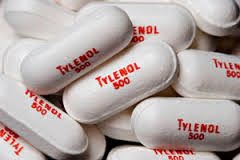 relief. In this analysis, it shows that whether you receive acetaminophen or a sugar pill, you had the same amount of pain relief – meaning that active drug had no real pain relief effect.
relief. In this analysis, it shows that whether you receive acetaminophen or a sugar pill, you had the same amount of pain relief – meaning that active drug had no real pain relief effect.
Although most of the patients I see find no relief from acetaminophen, a small percentage of patients do, so don’t completely dismiss this drug when it comes to helping your pain. However, if you do take acetaminophen, make sure that you’re not taking too much. The FDA recommends taking less than 3000mg a day. This means if you’re taking Extra Strength Tylenol (500mg), you can only take 6 pills a day, or regular strength, 300mg, 10 pills a day. Higher amounts can lead to liver damage that could even be life-threatening.
Smoking and Back Pain – is it related?
We all know that smoking is bad for you. In fact, since 1965, the Surgeon General’s Warning posted on every package of cigarettes says: Smoking Causes Lung Cancer, Heart Disease, Emphysema, And May Complicate Pregnancy. But did you know that in addition to the myriad of illnesses that are related to tobacco and smoking, recent studies show that smokers have a higher prevalence of back pain than non-smokers? It’s true.
Several studies in the 1980s and 1990s have shown a correlation between smoking and increased back pain. More recently, a  meta-analysis was done in 2010, which basically means a large number of studies (in this case, 40) were put together, and the results were compared to see what pattern, if any, existed between back pain and smoking. This meta-analysis concluded that current and former smokers have a higher prevalence of back pain. It even made the comparison between adult smokers to adolescent smokers; adolescents showed a higher prevalence of back pain. Therefore, we can conclude, the earlier one smokes, the greater risk to your back.
meta-analysis was done in 2010, which basically means a large number of studies (in this case, 40) were put together, and the results were compared to see what pattern, if any, existed between back pain and smoking. This meta-analysis concluded that current and former smokers have a higher prevalence of back pain. It even made the comparison between adult smokers to adolescent smokers; adolescents showed a higher prevalence of back pain. Therefore, we can conclude, the earlier one smokes, the greater risk to your back.
Is there a technical or medical reason behind this connection? Indeed. Smoking causes constriction of blood vessels, which reduces the amount of blood going to your muscles. Decreased blood results in decreased oxygen, which is one of the most important factors in initiating muscle pain. Some smokers actually had parts of their arms and legs amputated because of dead tissue caused by too little oxygen.
Do you want be free of back pain? Put out that cigarette and quit smoking!
When Making Medical Decisions About Pain Relief, Is More Information Better?
In today’s world we are bombarded by information and ways to obtain it. Do you want to know how many steps you take a day? Just buy a device and it will calculate it for you. Care to know what your cholesterol levels are? Simply go get a kit at your nearest drug store. Is it possible we are gathering too much information for our own good?
The same question can be asked about medical testing. Is it useful or even helpful to know certain things about our bodies? Many of us have undoubtedly had the experience where we have gone to the doctor because we had pain and an imaging study was ordered. MRI, CT, and ultrasound can give us information about our bodies that would have been unimaginable in the past.
While technology in general is of course a huge benefit, at the Norman Marcus Pain Institute, we believe it is necessary to proceed with caution as we navigate through it all. At NMPI, one common problem we find in back pain, neck pain, and shoulder pain is the overuse and overreliance on imaging studies. “Abnormalities” are often found on imaging studies without any relation to one’s pain. In fact, seeing abnormalities is more common than seeing a “normal” spine! For example, up to 40% of people without back pain can have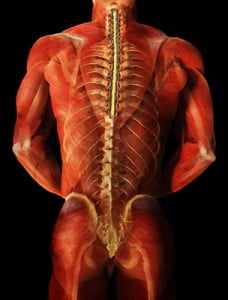 herniated discs and as many as 70% may have degenerated discs. That is why the US Institute of Medicine suggests not getting an MRI too quickly since you are likely to see one of these problems and assume it is the cause of your pain. This can lead to unnecessary nerve blocks and surgery.
herniated discs and as many as 70% may have degenerated discs. That is why the US Institute of Medicine suggests not getting an MRI too quickly since you are likely to see one of these problems and assume it is the cause of your pain. This can lead to unnecessary nerve blocks and surgery.
At NMPI, we often see patients who have a herniated disc, yet they only have pain in their back and buttock. They have not experienced any radiation into the leg(s) at all. In these patients, the pain generally has nothing to do with the disc herniation since disc herniation pain generally radiates down the leg and into the foot. Even when the patient is experiencing pain down the leg with a herniated disc found on MRI, muscles in the low back and buttocks may be the cause of the pain. If muscles are not examined as a potential cause, you may undergo an apparently reasonable surgery, without achieving relief of pain. Some studies show that up to 50% of spine surgeries fail (resulting in failed back surgery syndrome) and one of the reasons is the failure to identify muscles that were the true source of the pain.
Most back pain and neck pain is caused by soft tissue such as muscles and tendons. This is confusing because you may have been told your pain is from your spine, discs, or nerves. The problem is most people as they get older have signs of wear and tear on their x-rays and MRIs, but these common signs of aging may not explain your pain if the pain actually originates in your muscles. That’s why we say, when diagnosing persistent pain it’s not having “more” information at hand, it’s having the “right” information at hand.
At NMPI, we often see patients who experience persistent pain even after multiple spine surgeries. Our non-surgical, non-invasive treatment program has most of our patients leaving our office free of long standing back, neck, shoulder, and headache pain.
What To Do When Back Pain Causes Overdose?
“We don’t appreciate what we have until it’s gone.” If only we had a dime for every time we heard this. Perhaps the reason it is such a common expression is the simple truth in it. This certainly applies to our health, but specifically our backs. We probably all take our good health in vain, until something goes wrong. By the time we are in our forties over twenty percent of us experience some form of back pain. And what do we do when we experience pain? Well, unfortunately many people will turn to strong painkillers. This means opioids, morphine-like painkillers. And, while we have written about this topic in the past, there is something new on the horizon. Evzio, the brand name of injectable Naloxone, is a prescription medicine that can block the effects of morphine and related painkillers. Approved by the FDA in April 2014, it allows a patient to quickly treat themselves or be treated by a family member if the patient has overdosed on opioids.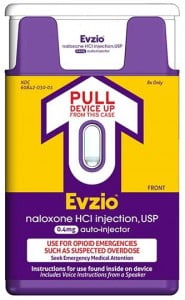
In the past, Evzio was difficult to obtain due to its high cost. However, recently The Clinton Foundation announced that it has negotiated a lower price for Evzio (see NYT article). This will allow municipalities to more easily purchase this medication, making it more available to those who need it.
It is a sad reality that many people will turn, in desperation, to painkillers as an answer to their aching backs. We, at the Norman Marcus Pain Institute, only use opioids as a last resort. Our method of finding the source of the pain and treating it has eliminated back pain for thousands of patients.. Nevertheless, with the rise of overdoses each year, the increased availability of naloxone to non-medical personnel will allow lives to be saved.
Is Looking Good Worth Having Back Pain?
There is an old expression, “beauty is pain.” Does it need to be? Is it worth risking your long-term health? Why do women wear high-heeled shoes when they know that looking beautiful in the moment may cause them pain down the road? Scientists from the Universite de Bretagne-Sud recently conducted experiments, which studied the effects of high-heeled women on men. Women who wore higher heels (3-4 inches vs. 2 inch heels) were able to get more men to answer survey questions on the streets and were picked up faster in bars and clubs. These studies show some type of empowerment in women with high-heeled shoes.  Knowing that this empowerment exists, and as fashion has increased the height of heels from 4 inches to 5 inches, we would like to remind you that walking for extended periods in high heels can cause calf tendons to shorten and possibly result in an increase in low back pain.
Knowing that this empowerment exists, and as fashion has increased the height of heels from 4 inches to 5 inches, we would like to remind you that walking for extended periods in high heels can cause calf tendons to shorten and possibly result in an increase in low back pain.
Here at the Norman Marcus Pain Institute, we see patients that run the gamut of factors causing their back pain. Prevention is always the best treatment; since low back pain affects so many of us a simple intervention is being more conscious of our shoes! While those Manolo Blahniks and Jimmy Choos may be stunning, they may be causing a problem for you down the line. At NMPI, we won’t say don’t wear them, just please, wear them in moderation.
Rafael Nadal will receive stem cell therapy for back pain – Should You?
Earlier in November, Rafael Nadal, the 14-time Grand Slam winner, announced he would receive stem cell treatment to help heal his ailing back, the same type of treatment he received for his knee. His doctor in Barcelona, Dr. Angel Ruiz-Cotorro, who has been treating Nadal for 14 years, said, “Nadal’s back pain is ‘typical of tennis’ players in that the treatment is meant to help repair his cartilage.” Stem cells were recently extracted from Nadal for a cultivation process to “produce the necessary quantities,” said Ruiz-Cotorro. Once cultivated, the stem cells will be placed into the joints of his spine with the goal of regeneration of cartilage as well as for an anti-inflammatory effect. Dr. Ruiz-Cotorro predicts that Nadal can return to training in early December.
Will stem cell treatment work for Nadal’s Back Pain?
Stem cell treatment may seem logical in certain situations – for example, if you have a mechanical problem where a knee has worn out cartilage, causing bone to rub against bone, it makes sense to use stem cells to grow new cartilage to have a cushion to protect the bone and cause the knee to be less painful. As much as we may want to see him back on the courts  grabbing more grand slam titles, if Nadal’s stem cell treatment is being used to eliminate his pain by repairing his joints or discs, the actual cause of his back pain may not be addressed.
grabbing more grand slam titles, if Nadal’s stem cell treatment is being used to eliminate his pain by repairing his joints or discs, the actual cause of his back pain may not be addressed.
Where does back pain originate?
The number one reason for back pain is muscular and other soft tissue, yet muscles are rarely evaluated as the cause of back pain. The only way to determine if Nadal’s back pain is from soft tissue and similar to most people with back pain would be a physical examination of Nadal’s back that included identifying possible muscles as the cause of his pain.
Some doctors believe that the disc, the cushion between the bones of the spine (the vertebra), is a major cause of back pain. They believe that surgeries to correct the flattening or herniation of the disc will decrease or eliminate back pain. Sometimes they are right, but they are just as likely to be wrong. The truth is that there is as high as a 50% failure rate for spine surgeries that were done to eliminate back pain thought to be related to disc problems. There are other joints in the spine that are thought to cause pain; one of them is the facet joint, which could also be a target for stem cell treatments.
When doctors rely on an MRI or CT scan to determine the source of the pain, the information obtained is often confusing. If a surgeon sees an abnormality on an MRI, he will often point to that abnormality as the cause of the pain; in my experience the abnormality found on an MRI or CT scan frequently is not the cause. In fact, if you randomly selected 100 people off the street, and perform an imaging scan, 40 may present with a herniated disc and have no pain and absolutely no awareness of their herniated disc; 70 may have degenerated (worn) discs with no pain, and a large number will have facet joint abnormalities. Therefore, finding an “abnormality” is more common than not. One, then, can deduce that the abnormality is more likely NOT the source of the pain. So treating the abnormality (with steroid injections, surgery, or stem cells) may therefore not relieve the pain.
Stem Cell Treatment and Sports Stars
Nadal, currently ranked as the number 3 professional tennis player in the world, is not the first sports star to chase after a “miracle cure.” The Denver Bronco quarterback Payton Manning and Yankees pitcher Bartolo Colon both went abroad to seek out stem cell treatment as a quick fix to get back in the game. (They both seem to be doing better overall, but it is inconclusive if the stem cell treatment was the cause of their recovery).
Will it work?
In the laboratory, it has been possible to demonstrate the ability of stem cells (most commonly found in the developing embryo and newborn) to grow new tissue. These cells are like silly putty; they can turn into, or adapt, to become any type of tissue. For example, a stem cell in the right environment in the body could become bone, cartilage or some organ (for example, liver or pancreas). But, it hasn’t been as easy to grow tissue in an actual person. There are some early studies that show that stem cells “may” relieve back pain, but both the doctors who are testing the technique and outside experts say much more research is needed before they can say whether the treatment offers real relief.
The use of stem cell therapies continues to be a hot topic for debate in the sports medicine and orthopedic surgery worlds. There is no current evidence-based research to prove that it works.
Sir William Osler, a famous physician, once said: “Use every new treatment as quickly as possible before it stops working.” Stem cell treatment needs to be further investigated to determine if stem cell treatments indeed work, and if so, for what conditions?
Is Bad Weather To Blame For Your Lower Back Pain?
A New York Times article Weather May Not Affect Back Pain, printed mid-July, cited a study showing that weather may not affect back pain. The purpose of the study was to explore the often-heard complaint from patients diagnosed with persistent pain related to muscles and bones (musculoskeletal pain) that weather changes cause an increase in pain. The study was based on an analysis of 993 patients who had seen their physician in 2011-2012 complaining of an episode of sudden back pain. These were not patients with a history of back pain.
So this article does not actually examine patients who already have back pain to see if the pain is increased with bad weather. In my practice, at NMPI, I have patients who can tell me a snowstorm is coming 3 days before it occurs. Although studies of the association between weather and pain are not uniformly supportive of the connection, a study done in 1995 of 558 patients with chronic pain found that 2/3 experienced an increase in pain and most of them prior to the occurrence of the bad weather.
 I have patients whose pain is so severe with bad weather that they can hardly get out of bed. Although there is no good scientific explanation for this association, some suggestions have been offered. When the barometric pressure falls, the air pressure in a painful joint may continue to be a little higher than the air pressure on the outside of the body, causing an increase in pain. Another explanation is that cold and/or inclement weather decreases the amount of time you are outside and active. Patients with musculoskeletal problems (i.e. muscle pain and arthritis) often feel worse with inactivity. In addition cold weather causes the blood vessels in the hands and feet to constrict, which can decrease the amount of available oxygen, resulting in increased muscle pain.
I have patients whose pain is so severe with bad weather that they can hardly get out of bed. Although there is no good scientific explanation for this association, some suggestions have been offered. When the barometric pressure falls, the air pressure in a painful joint may continue to be a little higher than the air pressure on the outside of the body, causing an increase in pain. Another explanation is that cold and/or inclement weather decreases the amount of time you are outside and active. Patients with musculoskeletal problems (i.e. muscle pain and arthritis) often feel worse with inactivity. In addition cold weather causes the blood vessels in the hands and feet to constrict, which can decrease the amount of available oxygen, resulting in increased muscle pain.
If your history indicates that bad weather causes an increase in your pain, it is likely that your flare up is most likely not an indicator of physical deterioration. Additional pain can be reasonably treated with increased medication for the brief period of weather related pain.
Concerns about the Growing Misuse of Opioids – Prescription Painkillers
From 1991 to 2009, the number of prescriptions written for the strongest pain medications tripled. These medications are collectively named opioids and include morphine, oxycodone, and hydrocodone.Opioids are a type of pain drug that may cause serious side effects. From 2005 to 2009, the number of emergency room visits for nonmedical use of prescribed pain medication doubled. Therefore, the states and federal governments are acting to try to limit the amount of pain medication being prescribed.
At NMPI, we focus on finding the most effective treatment to relieve our patients’ pain – without surgery, steroid injections, or heavy painkillers. However, when a patient complains of severe pain and is not responding well to other pain medications, stronger, prescription opioids will be given.
 Some opioids, such as oxycodone, are often combined with Tylenol (acetaminophen) in one pill. Some examples of these combination drugs are Lorcet, Lortab, Norco, Vicodin (are all hydrocodone and acetaminophen), and Percocet (oxycodone and acetaminophen). Most often, severe pain is related to a condition that will improve over time. Ideally, all prescription pain medications should be given only while severe pain persists. Like any medication, there are risks and side effects:
Some opioids, such as oxycodone, are often combined with Tylenol (acetaminophen) in one pill. Some examples of these combination drugs are Lorcet, Lortab, Norco, Vicodin (are all hydrocodone and acetaminophen), and Percocet (oxycodone and acetaminophen). Most often, severe pain is related to a condition that will improve over time. Ideally, all prescription pain medications should be given only while severe pain persists. Like any medication, there are risks and side effects:
• Opioids can make you drowsy – which raises the risk of falling and severe injury
• Opioids when mixed with alcohol, anti-anxiety medication, seizure medication, muscle relaxants, or sleep-aids can be deadly.
• Opioids cause constipation and can lower sex drive.
• Patients can become physically and psychologically dependent on opioids.
• Overtime a patient with chronic pain can develop a tolerance for the opioid and need a higher dosage.
Keep in mind that not all pain requires such strong medication, and most patients with pain can be managed with drugs such as acetaminophen (Tylenol) and aspirin-like drugs, called non-steroidal anti-inflammatory drugs (such as ibuprofen and Naproxen). When taken as directed, these less powerful drugs may be all that you need. (There are potential serious side effects with acetaminophen and NSAIDs, which I will discuss in a future blog.) For certain pains, some drugs are better than others. Sometimes we find that a drug we have been using may not actually be effective. A New York Times article on July 23, 2014 reported that for treating low back pain, acetaminophen was no better than a placebo.
Physicians have a responsibility to properly care for patients in pain. Some of these patients may appear to be at a higher risk to abuse opioids. Occasionally, patients complain of non-existent pain to obtain opioids for its mood-altering affect, called a “high.” The fact is that physicians who had been writing too many prescriptions for pain medication are now wary of prescribing any potentially habit-forming pain drugs. This has resulted in a decrease in emergency room visits for drug overdose and deaths from overdose, but it has also resulted in depriving many patients of medication they legitimately need to function normally.
At NMPI, when we treat patients in pain who have a history of drug abuse or who test positive on a written test to determine the risk of abuse, I believe that these two basic American traditions should be the guiding principles:
1. Innocent until proven guilty; and
2. In the words of Ronald Reagan, Trust but verify. Those patients who have problems or are at risk to not properly use pain medication need extra attention, not condemnation. They may be more difficult to treat, but that is why there are specialists to deal with complex pain problems.
Platelet Rich Plasma Injections (PRP) are not effective for Hamstring injuries
PRP injections have become a frequently used treatment for painful muscle and tendon injuries despite there being no rigorous studies of its effectiveness[1]. PRP involves the drawing of blood from the injured patient, spinning it down to collect the platelets and then injecting the platelets into the injured tissue. The rationale is that platelets will provide growth factors that will make you heal faster.
A study[2] reported on in a letter to the New England Journal of Medicine found that athletes with hamstring injuries recovered no better with PRP than with placebo (a salt water injection). In a randomized double blind controlled study (RCT), in which 80 recreational and professional athletes with hamstring injuries received either PRP or placebo injections, there was no difference in the average amount of time it took for each group to return to normal activities. In other words, in this study, injections with salt water were as effective as the $1600 injection of platelets. It is often difficult to treat pain related to muscles and tendons. For anyone in pain, a suggested treatment that can get you better faster and is offered by respected physicians is hard to resist. The problem is that without carefully studying a new procedure, compared to a similar control treatment, it is not possible to be sure that the new treatment actually works better. This first RCT of PRP for hamstring injuries suggests that it may not be a reasonable approach to painful muscle injuries.
If the assessme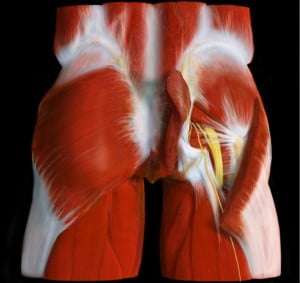 nt of muscle pain was a routine part of the physical examination, time, money and suffering could be minimized. At the Norman Marcus Pain Institute, our approach to painful muscles following injury is based on the work of my mentor, Hans Kraus, M.D., President JFK’s physician for the treatment of his back pain. Painful muscles are frequently the result of tension, weakness, stiffness, spasm or altered muscle tissue (usually referred to as trigger points).
nt of muscle pain was a routine part of the physical examination, time, money and suffering could be minimized. At the Norman Marcus Pain Institute, our approach to painful muscles following injury is based on the work of my mentor, Hans Kraus, M.D., President JFK’s physician for the treatment of his back pain. Painful muscles are frequently the result of tension, weakness, stiffness, spasm or altered muscle tissue (usually referred to as trigger points).
At the Norman Marcus Pain Institute, our physical examination tests for all these causes of pain so that the simplest cost effective treatments can be provided prior to using any invasive procedures. Sometimes severe pain is quickly eliminated with our exercise, electrical stimulation and laser protocols that are described in detail in my book End Back Pain Forever. Your pain may require medication and injections, because one size does not fit all.
[1] Moraes VY, Lenza M, Tamoki MJ, Faloppa F, Belloti JC. Platelet-rich therapies for musculoskeletal soft tissue injuries. Cochrane Database Syst Rev. 2013.
[2] Reurink G, Goudswaard GJ, et al. Platelet-Rich Plasma Injections in Acute Muscle Injury. N Engl J Med. 2014:370:2546-2547.
Sometimes the pain isn’t coming from where you think
I recently saw Fred, a 30 year old male, who complained of significant neck pain and shoulder pain. The pain on his left side was much greater than on the right. He tried several chiropractic treatments, massage, physical therapy, acupuncture, and exercises without relief of his pain.
When I first examined Fred, I found two muscles that were painful, his anterior and medial scalenes on both sides. The scalenes are muscles that go from the side of the neck down to the 1st rib as it sits under the clavicle (collarbone). Since he complained mostly of pain on his left neck and shoulder, I injected his left scalenes, followed by 3 days of physical therapy (which included neuromuscular electrical stimulation and gentle, limbering exercises). Fred claimed that the pain on the left subsided, but he noticed that the right side was now more painful. So, the following week, he had his right scalenes treated (with injections into the muscle, followed by 3 days of physical therapy). Fred reported a significant decrease in his overall pain, and reported only soreness at the injection sites.
I followed up with Fred approximately one month later. He reported to me that his overall pain level continued to stay low, but he noticed that when he looked up, he felt tightness on the left side of his neck. When I examined him, I found two muscles to be contributing to his pain, the Serratus Anterior and the Subscapularis. These muscles are in his shoulder. He was very shocked to learn that tightness in his neck was caused by muscles in his shoulder!!
Once these muscles were treated, he reported that the tightness in his neck was released. Sometimes we have to look for muscles contributing to pain in areas other than where you may be feeling it. This is called referred pain. If I had continued to treat muscles in Fred’s neck, he may never have had relief!
Stiffness is an important aspect of muscle pain
I recently saw George, a 48-year-old man, who suffered from pain, described as soreness in the thighs, neck, shoulders and arms, and tingling in his calves and shin. Sitting for more than two hours or sitting for more than 20 minutes would cause an increase in his pain. Bending over also brought on his pain.
George had tried physical therapy on multiple occasions, and saw two neurologists, who could not find anything that would explain his pain.
When I examined him, I found him to be strong but very stiff. When he bent over, he was able to reach within 14 inches of the floor. When he lied on his back and lifted one leg up at a time, he was able to reach only 57 degrees (85 75 degrees is normal). Because he was so stiff, I decided to start a course of exercises that would help increase his range of motion.
Over the next few weeks, George learned all 21 of the Kraus-Marcus exercises, which he was advised to do every day. As he did the exercises, he noticed that his pain level was decreasing and wasn’t occurring as often as usual. When he was taught the last 7 exercises, he was able to bend over to within 9 inches of the floor, and could lift each leg to 80 degrees.
A month later, George reports a 90% decrease in his overall pain. Sometimes we find that starting with the most conservative of treatments can prevent us from performing more costly and dangerous treatments. Very often, stiffness is an important aspect of one’s pain that can easily be found and treated!
Case Study: Low Level Laser Therapy
Gregory is a 29 year old manager whose job requires that he travel often. He came to see me for pain at the back of the left side of his neck which he often felt upon waking up, and during or after jogging over the past 4-5 years. An MRI showed that his neck did not have any significant spinal abnormalities that might be causing his pain, but a physical examination revealed three muscles that were likely the source of his pain.
I began treating Gregory with a 15 watt class 4 laser. On his second day of treatment, he reported that he felt no pain in the left side of his neck when he woke up, but that the pain had moved to the right side of the neck and shoulder. I continued treating the left side of his neck, and also began to treat the right side with the laser.
When he returned for the third day of treatment, the pain in the left side of his neck was completely gone, and the right side’s discomfort was significantly reduced. At a two month follow-up, his pain was gone.
He is now able to go jogging without any pain in his shoulders or neck. By starting with a conservative treatment approach, Gregory was able to avoid invasive or costly procedures, and regain function.
Low-Level Laser Therapy
One lesser-known but valuable tool for multiple painful conditions is the low-level laser. The laser is a source of extremely pure, organized light, as opposed to something like a regular light bulb, which emits a scattered, disorganized light. We can liken organized light to the sound of a flute playing a single note, and disorganized light to the sound of a stone rolling around in a tin can. The laser is a non-painful treatment option that affects the local (near the area being treated) immune system, blood circulation, and the release of different chemicals that affect how we experience pain.
While it isn’t clear exactly how the laser helps a variety of painful conditions, there are two proposed means by which the laser improves pain:
- The light energy (called photons) is absorbed in the injured area and stimulates the production of Cytochrome C. Cytochrome C is a protein involved in cell metabolism and energy. When Cytochrome C is stimulated, it revs up the cell’s metabolism, and gives the cells more energy to heal the injured area.
- The light energy from the laser leads to the production of small amounts of singlet oxygen. Singlet oxygen is a reactive form of oxygen, which means that it is very easy for this type of oxygen to take part in chemical reactions. At high doses, singlet oxygen can be destructive, and has been used in cancer treatment to destroy cancerous cells. At very low doses, singlet oxygen can increase the number of cells. This may be one way the laser helps promote tissue repair.
The laser in a non-invasive, non-painful treatment option that can, in some cases, produce results immediately. For pain that has been around for a long time, more than one treatment session is usually needed for best results.


